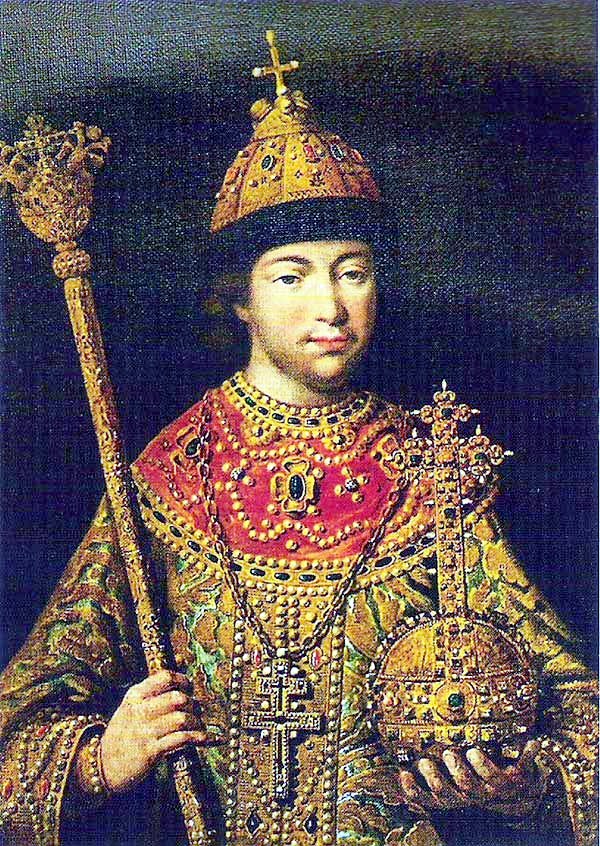Week 7
 Michael I (Mikhaíl Fyodorovich Románov) (1596 – 1645) became the first Russian Tsar of the House of Romanov after the zemskiy sobor of 1613 elected him to rule the Czardom of Russia. He was the son of Feodor Nikitich Romanov (later known as Patriarch Filaret) and of Xenia (later known as "the great nun" Martha). He was also a first cousin once removed of the last Rurikid Czar Feodor I through his great-aunt Anastasia Romanovna, who was the mother of Feodor I, and through marriage, a great-nephew in-law with Czar Ivan IV of Russia. His accession marked the end of the "Time of Troubles". During his reign, Russia conquered most of Siberia, largely with the help of the Cossacks and the Stroganov family. Russia had extended to the Pacific Ocean by the end of Michael's reign. Michael's grandfather, Nikita, was brother to the first Russian Tsaritsa Anastasia and a central advisor to Ivan the Terrible. As a young boy, Michael and his mother had been exiled to Beloozero in 1600. This was a result of the recently elected Tsar Boris Godunov, in 1598, falsely accusing his father, Feodor, of treason. This may have been partly because Feodor had married Ksenia Shestova against Boris' wishes. Michael was unanimously elected Tsar of Russia by a national assembly on 21 February 1613, but the delegates of the council did not discover the young Tsar and his mother at the Ipatiev Monastery near Kostroma until 24 March. He had been chosen after several other options had been removed, including royalty of Poland and Sweden. Initially, Martha protested, believing and stating that her son was too young and tender for so difficult an office, and in such a troublesome time. (Wikipedia)
Michael I (Mikhaíl Fyodorovich Románov) (1596 – 1645) became the first Russian Tsar of the House of Romanov after the zemskiy sobor of 1613 elected him to rule the Czardom of Russia. He was the son of Feodor Nikitich Romanov (later known as Patriarch Filaret) and of Xenia (later known as "the great nun" Martha). He was also a first cousin once removed of the last Rurikid Czar Feodor I through his great-aunt Anastasia Romanovna, who was the mother of Feodor I, and through marriage, a great-nephew in-law with Czar Ivan IV of Russia. His accession marked the end of the "Time of Troubles". During his reign, Russia conquered most of Siberia, largely with the help of the Cossacks and the Stroganov family. Russia had extended to the Pacific Ocean by the end of Michael's reign. Michael's grandfather, Nikita, was brother to the first Russian Tsaritsa Anastasia and a central advisor to Ivan the Terrible. As a young boy, Michael and his mother had been exiled to Beloozero in 1600. This was a result of the recently elected Tsar Boris Godunov, in 1598, falsely accusing his father, Feodor, of treason. This may have been partly because Feodor had married Ksenia Shestova against Boris' wishes. Michael was unanimously elected Tsar of Russia by a national assembly on 21 February 1613, but the delegates of the council did not discover the young Tsar and his mother at the Ipatiev Monastery near Kostroma until 24 March. He had been chosen after several other options had been removed, including royalty of Poland and Sweden. Initially, Martha protested, believing and stating that her son was too young and tender for so difficult an office, and in such a troublesome time. (Wikipedia)
A NOTE ON CZAR VERSUS TSAR:
Tsar also spelled czar, tzar, or csar, is a title used to designate East and South Slavic monarchs or supreme rulers of Eastern Europe, originally the Bulgarian monarchs from 10th century onwards, much later a title for two rulers of the Serbian Empire, and from 1547 the supreme ruler of the Tsardom of Russia and the Russian Empire. In this last capacity it lends its name to a system of government, tsarist autocracy or tsarism. The term is derived from the Latin word caesar, which was intended to mean "emperor" in the European medieval sense of the term—a ruler with the same rank as a Roman emperor, holding it by the approval of another emperor or a supreme ecclesiastical official (the Pope or the Ecumenical Patriarch)—but was usually considered by western Europeans to be equivalent to king, or to be somewhat in-between a royal and imperial rank.
"Tsar" and its variants were the official titles of the following states:
Bulgarian Empire (First Bulgarian Empire in 919–1018, Second Bulgarian Empire in 1185–1396)
Serbian Empire, in 1346–1371
Tsardom of Russia, in 1547–1721 (replaced in 1721 by imperator in Russian Empire, but still remaining in use, also officially in relation to several regions until 1917)
The first ruler to adopt the title tsar was Simeon I of Bulgaria.
REQUIRED READING
